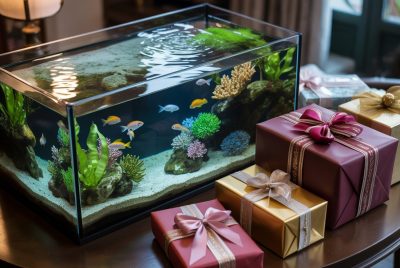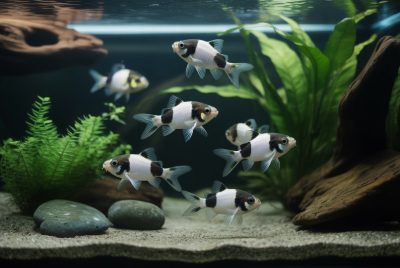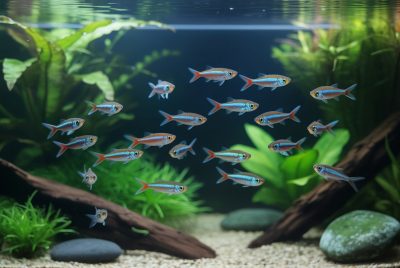Dwarf Gourami Care: Complete Guide to Personality & Breeding
*We may earn a commission for purchases made using our links. Please see our disclosure to learn more.
The gentle bubble-nest floating at the water’s surface tells a story of dedication and instinct. Below, a vibrant dwarf gourami tends to his carefully constructed creation, each bubble placed with purpose. This scene captures the essence of what makes dwarf gouramis such captivating aquarium inhabitants – their complex behaviors, stunning colors, and fascinating breeding rituals that transform any tank into a window into aquatic life.
Dwarf gouramis represent one of the most rewarding freshwater fish species for aquarium enthusiasts. Their combination of manageable size, brilliant coloration, and engaging personality traits make them ideal for both novice and experienced fishkeepers seeking to create a dynamic aquatic environment.
“The dwarf gourami’s ability to breathe atmospheric air through its labyrinth organ makes it one of the most adaptable freshwater species, capable of thriving in conditions that would stress other tropical fish.”
– Journal of Aquatic Biology Research
Key Takeaways
- Tank Requirements: Minimum 10-gallon tank with gentle filtration and stable water parameters
- Personality Traits: Generally peaceful but can show territorial behavior during breeding
- Compatible Tankmates: Best with similarly sized, non-aggressive community fish
- Breeding Behavior: Males build elaborate bubble nests and provide extensive parental care
- Health Considerations: Susceptible to dwarf gourami disease; requires pristine water quality
- Feeding Needs: Omnivorous diet with high-quality flakes, pellets, and occasional live foods
Understanding Dwarf Gourami Personality
The Complex Nature of Dwarf Gouramis
Dwarf gouramis exhibit a fascinating blend of timid and assertive behaviors that make them endlessly interesting to observe. These fish demonstrate remarkable intelligence, often recognizing their caretakers and displaying distinct feeding responses when approached. Their personality shifts dramatically based on their environment, companions, and breeding status.
During non-breeding periods, dwarf gouramis typically display peaceful, somewhat shy behavior. They prefer areas with adequate plant cover and gentle water movement, often seen exploring the middle and upper levels of the aquarium. However, this demeanor transforms significantly when breeding conditions arise.
Territorial Dynamics and Social Hierarchy
The territorial nature of dwarf gouramis becomes most apparent when males establish breeding territories. During this phase, previously docile fish may chase away perceived threats and become increasingly protective of their chosen area. This behavior isn’t aggression in the traditional sense but rather an instinctual drive to secure optimal breeding conditions.
Understanding these personality shifts helps aquarium keepers create environments that accommodate both the peaceful community aspects and the natural breeding behaviors of these remarkable fish. The key lies in providing adequate space, hiding spots, and careful tankmate selection.
Creating the Ideal Dwarf Gourami Environment
Tank Setup and Water Parameters
Successful dwarf gourami care begins with understanding their natural habitat preferences. These fish thrive in well-planted aquariums with gentle water movement and stable conditions. A minimum tank size of 10 gallons provides adequate space for a single dwarf gourami, though larger tanks allow for more natural behaviors and potential tankmates.
Water parameters play a crucial role in maintaining healthy, vibrant dwarf gouramis. The ideal temperature range spans 72-82°F (22-28°C), with slightly acidic to neutral pH levels between 6.0-7.5. Water hardness should remain moderate, typically 4-10 dGH, mimicking their natural soft water origins.
The filtration system requires careful consideration, as dwarf gouramis prefer gentle water movement. Strong currents can stress these fish and interfere with their natural behaviors, particularly bubble nest construction. A quality sponge filter or adjustable hang-on-back filter provides adequate biological filtration without creating excessive turbulence.
Plant Selection and Aquascaping
Live plants serve multiple purposes in a dwarf gourami aquarium beyond aesthetic appeal. Floating plants like water lettuce or hornwort provide essential cover and help maintain stable water conditions. These plants also offer ideal anchor points for bubble nests, supporting natural breeding behaviors.
Mid-level plants such as Amazon swords, cryptocorynes, and anubias create territories and hiding spots that reduce stress and allow fish to establish natural hierarchies. The combination of open swimming areas and planted refuges creates an environment where dwarf gouramis can express their full range of natural behaviors.
Compatible Tankmates and Community Dynamics
Selecting Appropriate Companions
Choosing compatible tankmates requires understanding the specific needs and behaviors of dwarf gouramis. Ideal companions share similar water parameter requirements while displaying non-aggressive temperaments that won’t stress or intimidate these relatively peaceful fish.
Excellent tankmate options include tetras, rasboras, corydoras catfish, and peaceful barbs. These species occupy different tank levels and feeding niches, reducing competition while adding activity and color to the aquarium. Small, peaceful bottom-dwellers like kuhli loaches complement dwarf gouramis perfectly, utilizing different areas of the tank without territorial conflicts.
Species to Avoid
Certain fish species create problems in dwarf gourami communities despite appearing compatible on paper. Aggressive or nippy fish like tiger barbs, larger cichlids, or fin-nipping species can stress dwarf gouramis and damage their delicate fins. Similarly, very active or boisterous species may overwhelm these more reserved fish.
Large or predatory species pose obvious risks, but even moderately sized aggressive fish can create ongoing stress that compromises dwarf gourami health and natural behaviors. The key principle involves selecting tankmates that share similar temperaments and environmental needs.
Managing Multiple Dwarf Gouramis
Keeping multiple dwarf gouramis requires careful planning and adequate space. Male dwarf gouramis can become territorial, especially during breeding periods, making proper tank size and layout crucial for success. A general rule suggests providing at least 10 gallons per additional dwarf gourami, with plenty of visual barriers and territory markers.
Female dwarf gouramis typically show less territorial behavior, making all-female groups more manageable in smaller spaces. However, mixed-gender groups offer the most natural social dynamics and potential breeding opportunities for dedicated aquarists.
Breeding Dwarf Gouramis: A Fascinating Process

Pre-Breeding Preparation
Successful dwarf gourami breeding requires understanding their complex courtship and spawning behaviors. The process begins weeks before actual spawning, as males establish territories and begin constructing elaborate bubble nests. These intricate structures demonstrate the male’s fitness and provide essential protection for developing eggs and fry.
Creating optimal breeding conditions involves maintaining pristine water quality, providing appropriate nesting sites, and ensuring adequate nutrition for breeding pairs. Slightly warmer water temperatures (78-82°F) and reduced water levels can trigger breeding behaviors, while live or frozen foods help condition breeding fish.
The Spawning Process
Dwarf gourami spawning represents one of the most fascinating breeding displays in freshwater aquariums. Males court females through elaborate displays, showing off their brightest colors while defending their bubble nest territories. The actual spawning involves the male embracing the female beneath the nest, releasing eggs and sperm simultaneously.
Following spawning, the male’s behavior shifts to intense parental care. He collects fallen eggs, places them carefully in the bubble nest, and maintains the structure while defending against all perceived threats. This dedicated care continues until the fry become free-swimming, typically 3-5 days after hatching.
Raising Dwarf Gourami Fry
Successfully raising dwarf gourami fry requires preparation and attention to detail. The tiny fry initially survive on their yolk sacs but quickly require microscopic foods like infusoria, liquid fry food, or freshly hatched brine shrimp. Maintaining stable water conditions becomes critical, as fry are extremely sensitive to parameter fluctuations.
Growth rates vary considerably, with some fry developing faster than others. This size disparity can lead to cannibalism, making frequent feeding and potential size-based separation necessary for optimal survival rates. Patience and consistency in care determine the success of raising healthy juvenile dwarf gouramis.
Health and Disease Prevention
Common Health Challenges
Dwarf gouramis face several health challenges that require proactive management and early intervention. Dwarf gourami disease, a viral infection specific to this species, represents the most serious threat. This condition causes lethargy, loss of appetite, and eventual death, with no known cure making prevention crucial.
Maintaining excellent water quality provides the foundation for preventing most health issues. Regular water changes, proper filtration, and avoiding overcrowding significantly reduce disease risks. Quarantining new fish before introduction helps prevent disease transmission to established aquarium inhabitants.
Nutritional Requirements
Proper nutrition supports immune system function and overall health in dwarf gouramis. These omnivorous fish require a varied diet including high-quality flakes or pellets as a base, supplemented with frozen or live foods like bloodworms, brine shrimp, and daphnia. Plant matter in the form of blanched vegetables or algae wafers provides essential fiber and nutrients.
Feeding frequency and portion control prevent overfeeding-related health issues while ensuring adequate nutrition. Two to three small meals daily work better than single large feedings, allowing fish to consume food completely while maintaining water quality.
Recognizing and Addressing Health Issues
Early recognition of health problems significantly improves treatment success rates. Changes in behavior, appetite, coloration, or swimming patterns often indicate developing issues before physical symptoms appear. Maintaining detailed observations helps identify problems early when intervention remains most effective.
Treatment options vary depending on the specific condition, ranging from water quality improvements to targeted medications. However, prevention through proper care remains more effective than treating established diseases, emphasizing the importance of consistent aquarium maintenance and monitoring.
Advanced Care Considerations
Seasonal Care Adjustments
Dwarf gourami care benefits from understanding their natural seasonal rhythms and adjusting aquarium conditions accordingly. Wild populations experience seasonal temperature and lighting variations that trigger breeding behaviors and activity patterns. Replicating these subtle changes can enhance natural behaviors and overall health.
During breeding seasons, increased feeding frequency and slightly elevated temperatures support reproductive activities. Conversely, cooler periods with reduced lighting can provide natural rest phases that help maintain long-term health and vitality.
Long-term Aquarium Management
Successful long-term dwarf gourami keeping requires consistent attention to water quality, equipment maintenance, and environmental stability. Regular testing and maintenance schedules prevent gradual parameter drift that can stress fish and compromise their immune systems.
Equipment redundancy and emergency planning protect valuable fish during power outages or equipment failures. Battery-powered air pumps, backup heaters, and emergency food supplies ensure continued care during unexpected situations.
Creating a Thriving Dwarf Gourami Community
Observing Natural Behaviors
The true reward of dwarf gourami keeping comes from observing their complex natural behaviors in a well-designed aquarium environment. From the intricate bubble nest construction to subtle social interactions, these fish provide endless fascination for dedicated aquarists.
Understanding and accommodating these natural behaviors creates aquarium environments where dwarf gouramis thrive rather than merely survive. This approach yields healthier, more active fish displaying their full range of natural colors and behaviors.
Building Expertise Over Time
Successful dwarf gourami keeping develops through experience, observation, and continuous learning. Each fish displays individual personality traits and preferences that become apparent through careful observation. This knowledge helps fine-tune care approaches and create increasingly optimal environments.
Connecting with other dwarf gourami enthusiasts through online forums, local aquarium clubs, or specialized groups provides valuable insights and support. Sharing experiences and learning from others accelerates the development of expertise while building a supportive community of fellow aquarists.
Conclusion
Dwarf gourami care encompasses far more than basic tank maintenance and feeding schedules. These remarkable fish offer aquarium enthusiasts the opportunity to observe complex behaviors, witness fascinating breeding rituals, and create dynamic aquatic communities that showcase the beauty and diversity of freshwater life.
Success with dwarf gouramis comes from understanding their unique personality traits, providing appropriate tankmates, and creating environments that support their natural behaviors. Whether observing the delicate construction of a bubble nest or watching the subtle interactions within a community tank, dwarf gouramis reward dedicated care with endless fascination and beauty.
The journey of dwarf gourami keeping continues to evolve with each observation, each successful breeding, and each new understanding of their complex needs. For those willing to invest the time and attention these fish deserve, dwarf gouramis offer one of the most rewarding experiences in freshwater aquarium keeping.
Frequently Asked Questions
Q: How long do dwarf gouramis typically live in aquarium conditions?
A: With proper care, dwarf gouramis typically live 4-6 years in aquarium settings. Excellent water quality, appropriate nutrition, and stress-free environments can extend their lifespan, while poor conditions or disease may significantly reduce it.
Q: Can dwarf gouramis be kept in unheated tanks?
A: Dwarf gouramis require tropical temperatures between 72-82°F (22-28°C) and cannot survive in unheated tanks in most climates. Their labyrinth organ allows them to breathe air, but they still need consistently warm water for optimal health and metabolism.
Q: How can you tell the difference between male and female dwarf gouramis?
A: Males typically display brighter colors, more pointed dorsal fins, and develop more intense coloration during breeding. Females remain smaller, show rounder body shapes when mature, and generally display more subdued coloration throughout their lives.
Q: What should you do if a dwarf gourami becomes aggressive toward tankmates?
A: Aggressive behavior often indicates territorial disputes, breeding behavior, or inadequate space. Increase hiding spots, ensure adequate tank size, check water parameters, and consider temporarily separating aggressive individuals until normal behavior returns.
Q: How often should dwarf gouramis be fed, and what foods work best?
A: Feed dwarf gouramis 2-3 small meals daily with high-quality flakes or pellets as a base diet. Supplement weekly with frozen or live foods like bloodworms, brine shrimp, or daphnia, and occasionally offer blanched vegetables for dietary variety and optimal nutrition.




